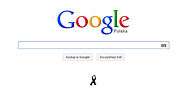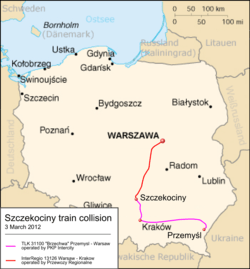Szczekociny rail crash
The Szczekociny rail crash occurred on 3 March 2012 when two passenger trains collided head-on near the town of Szczekociny, Silesian Voivodeship, Poland.[2] Sixteen persons died in the incident and 58 were injured.[2][4] The investigation into the collision began the next day,[5] and its report was published on 15 February 2013.[6]
| Szczekociny rail crash | |||
|---|---|---|---|
Video of the site after the incident | |||
| Details | |||
| Date | 3 March 2012 20:57 CET | ||
| Location | Chałupki near Szczekociny | ||
| Coordinates | 50°37′14″N 19°51′30″E | ||
| Country | Poland | ||
| Line | Kozłów—Psary | ||
| Operator | PKP Intercity, Przewozy Regionalne[1] | ||
| Incident type | Head-on collision | ||
| Statistics | |||
| Trains | 2 | ||
| Passengers | ~350 | ||
| Deaths | 16[2] | ||
| Injured | 58[2] | ||
| |||
Incident
At around 20:57 CET on 3 March 2012, two passenger trains (totalling approximately 350 passengers in 10 carriages[2][7]) collided at Chałupki near the Silesian Voivodship town of Szczekociny.[8] One train, the TLK 31100 Brzechwa operated by PKP Intercity, was travelling north from Przemyśl to Warsaw; the other was the InterRegio 13126 Matejko operated by Przewozy Regionalne, travelling south from Warsaw to Kraków at 95 kilometres per hour (59 mph).[1][2][9] At the time, scheduled engineering works were underway on the track at Szczekociny railway station.[2] A spokesman from Polish State Railways said that as a result of this, the Kraków-bound train was "on the wrong track". The InterRegio train was hauled by Class ET22 locomotive 1105,[2] and the Intercity by Class EP09-035.
Because of the collision, one carriage of the northbound Warsaw train telescoped, and other carriages derailed.[10] One eyewitness described carriages colliding like a concertina.[2]
One third of the EP09-035 engine room, along with both cabins, was completely destroyed. Locomotive ET22-1105 had one cabin (the front one) destroyed and rotated 180° as a result of collision.[11]
Casualties
Officials announced that the incident resulted in 16 fatalities and 58 injuries.[2] One of the fatalities was an American woman,[2] another a Russian national.[9] On 6 March 2012, Polish newspaper Gazeta Wyborcza reported that the drivers of both trains and a number of train staff died in the incident.[12]
Six Ukrainians, one Moldovan and one Czech were among the injured.[2][13] Szymon Nowak, a doctor in a nearby hospital, stated that a number of the casualties were in a serious condition; some were in medically induced comas.[14] The casualties were reported as having a variety of injuries including broken arms and legs, pelvic and spinal fractures, as well as facial and internal injuries. One 29-year-old female casualty had a leg amputated.[15]
The rescue operation involved approximately 450 firemen and 120 police officers.[16] 35 ambulances and 2 air ambulances took casualties to a number of hospitals, including those in Piekary Śląskie, Myszków, Częstochowa, Zawiercie, Katowice, Sosnowiec, Dąbrowa Górnicza and Bytom.[16]
As of 8 March 2012, 39 people remained in hospital.[17][18] Of these, 4 remained in intensive care.[17][19]
Investigation
On 4 March 2012, Polish prosecutors opened an investigation into the incident.[5] The following day, the Associated Press reported that one prosecutor, Tomasz Ozimek, was seeking to press charges against a railroad traffic controller. Ozimek alleges that the controller's error resulted in one of the trains moving onto the wrong track.[9] It was announced at a press conference in Częstochowa that two people were detained, without charge, including the controller, who is in psychiatric care suffering from shock.[9][18] The second person, a female dispatcher, was released on 6 March without charge.[18]
By 8 March, the line reopened after reconstruction work.[17] Polskie Radio reported that PKP acknowledged prior knowledge of faulty points on the line. Polish TV network TVN alleges that there was a second fault, at a signal, near to the points.[17]
The investigation revealed that a series of five mistakes caused the collision: (1) A switch malfunctioned and the traffic controller at Starzyny used a subsidiary signal, sending the southbound train (IR 13126 Matejko) on a wrong track instead of making the change manually, (2) the traffic controller failed to observe the moving train and informed his colleague at Sprowa post that the train proceeded on the correct track, (3) the driver of that train obeyed the subsidiary signal even though it conflicted with other signalling. Almost simultaneously, (4) the traffic controller at Sprowa noticed that the signal showed busy track yet she presumed that the safety system had malfunctioned and permitted northbound TLK 31100 Brzechwa to continue. Finally, (5) the driver of TLK 31100 Brzechwa also failed to obey conflicting signalling and continued. The official report was issued on 15 February 2013.[20]
Reactions

The President, Bronislaw Komorowski, declared two days of mourning beginning on Monday 5 March.[21] Polish Prime Minister Donald Tusk said that the incident was "[Poland's] most tragic train disaster in many, many years",[7] referring to the 1990 Ursus incident,[14] and that it was too soon to speculate what caused the Szczekociny collision.[7] Tusk added that human error could not be excluded from the lines of enquiry.[10]
Slawomir Nowak, the Minister of Transport, insisted that Polish rail travel was safe and that safety is a priority. He added that people planning to travel on the Polish railway system during Euro 2012 need not worry, stating that he believes that "the train system – not only in Poland but all of Europe – is still very safe".[22]
Pope Benedict XVI wrote to Archbishop Józef Michalik expressing condolences, stating that it was "with pain [he received] the news of the train crash". He gave all casualties of the incident his "apostolic blessing" and said that he was praying for the victims and their families.[15]
German Chancellor Angela Merkel and Foreign Minister Guido Westerwelle also sent Tusk and the victims' families their condolences.[23] President of Slovakia Ivan Gašparovič – along with Prime Minister Iveta Radičová and Foreign Minister Mikuláš Dzurinda – gave their sympathy to the families and relatives of the incident's victims.[23] Prime Minister of the Czech Republic Petr Nečas wrote to "express [his] grief over every human life that has perished in the disaster".[24] Andrius Kubilius, the Prime Minister of Lithuania, wished Poland "the strength required in those moments of grief and mourning".[24] Prime Minister of Hungary Viktor Orbán wrote to Tusk to reassure him that the "Hungarian people are joining [their] Polish friends in mourning".[24] Boyko Borisov, the Prime Minister of Bulgaria, sent his "most sincere condolences to the families and relatives of the victims", stating that the Bulgarian people "join [them] in pain".[24] The Prime Minister of Singapore Lee Hsien Loong wrote a letter to Tusk, expressing his "deepest condolences to the people of Poland".[25]
See also
| Wikimedia Commons has media related to Szczekociny rail crash. |
- List of rail accidents (2010–2019)
- List of Poland disasters by death toll
References
- Polish State Railways (4 March 2012). "Wypadek pociągu TLK Brzechwa relacji Przemyśl – Warszawa – SZCZEGÓŁY NA TEMAT ZDARZENIA". Retrieved 4 March 2012.
- "Poland suffers deadly train crash near Szczekociny". BBC Online. 4 March 2012. Retrieved 4 March 2012.
- Onet Wiadomosci :Krok po kroku – jak doszło do katastrofy kolejowej w Szczekocinach Archived 8 March 2012 at the Wayback Machine – Videoanimation(Polish)
- "Poland train collision". IANS Live. 4 March 2012. Retrieved 4 March 2012.
- "Death toll in Polish train collision rises to 15". Associated Press. 4 March 2012. Archived from the original on 20 March 2013. Retrieved 7 March 2012.
- "Archived copy" (PDF). Archived from the original (PDF) on 10 May 2013. Retrieved 25 July 2013.CS1 maint: archived copy as title (link)
- "Poland train crash: 16 killed after trains collide". Daily Telegraph. 4 March 2012. Retrieved 4 March 2012.
- "Catastrophic Train Collision in Silesia". Krakow Post. 3 March 2012. Retrieved 4 March 2012.
- Scislowska, Monika (5 March 2012). "Prosecutor to charge man in Polish train collision". Seattle Post-Intelligencer. Retrieved 4 March 2012.
- "At least 14 killed in Polish train crash". Financial Times. 4 March 2012. Retrieved 4 March 2012.
- http://rail.phototrans.eu/14,63952,0,PaFaWag_104Eb_EP09_035.html (in Polish)
- "Zidentyfikowano wszystkie ofiary katastrofy kolejowej". Gazeta Wyborcza (in Polish). 6 March 2012. Retrieved 7 March 2012.
- "Poland defends rail safety after collision kills 16". CTV News Winnipeg. 4 March 2012. Retrieved 9 March 2012.
- "Poland train crash leaves dozens dead or injured". The Guardian. 4 March 2012. Retrieved 4 March 2012.
- "Pope Benedict sends condolences to train crash victims' families". Polskie Radio. 6 March 2012. Retrieved 6 March 2012.
- "PM on Train Crash Site". Poland.pl. 7 March 2012. Retrieved 7 March 2012.
- "Tracks re-opened following crash". Polskie Radio. 8 March 2012. Retrieved 8 March 2012.
- "Train dispatcher released over deadly crash". Independent Online. 6 March 2012. Retrieved 6 March 2012.
- "Pair Detained Over Poland Train Crash". Wall Street Journal. 5 March 2012. Archived from the original on 6 April 2015. Retrieved 6 March 2012.
- http://www.rynekinfrastruktury.pl/artykul/72/1/raport-pkbwk-co-sie-wydarzylo-pod-szczekocinami.html
- Chmielewski, Janusz; Borowski, Chris (4 March 2012). "Poland to mourn 16 killed in head-on train crash". The Telegraph. Retrieved 4 March 2012.
- Scislowska, Monika (4 March 2012). "Poland defends rail safety after deadly crash". Associated Press. Retrieved 4 March 2012.
- "Szczekociny: wstępny bilans tragedii". Wydawnictwo Górnicze (in Polish). 6 March 2012. Retrieved 6 March 2012.
- "Condolences from Heads of Governments". Chancellery of the Prime Minister. Retrieved 7 March 2012.
- "MFA Press Release: Condolence Letter from Prime Minister Lee Hsien Loong to Prime Minister of Poland Donald Tusk". Retrieved 10 March 2012.
